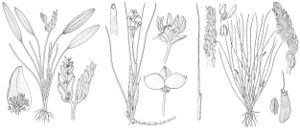Scheuchzeria palustris
Sp. Pl. 1: 338. 1753.
Herbs, glabrous. Rhizomes creeping, jointed, freely branching. Stems flexuous, zigzag, 1–4 dm. Leaves striate; cauline leaves gradually reduced to bracts; sheaths 1.5–10 cm, ligules 2–12 mm; hairs within leaf sheath 0.2–2 cm; blade 2–41 cm × 1–3 mm. Inflorescences 3–12-flowered, 3–10 cm; proximal bract foliaceous; distalmost sheaths sometimes bladeless; pedicels spreading, 5–25 mm. Flowers: tepals in 2 similar series of 3 each, white to yellow-green, lance-ovate to lanceolate, 1-veined, 2–3 mm, membranous, apex acute; filaments filiform; anthers linear, elongate; pistils 6–7 mm; styles oblong; stigmas papillose. Follicles light green to brown, ovoid, 4–10 mm, leathery, dehiscing on curved, adaxial side; beak 0.5–1 mm. Seeds brown to black, ovoid, 4–5 mm, smooth, hard; endosperm absent. 2n = 22.
Phenology: Flowering in late spring.
Habitat: Sphagnum bogs, marshes, and lake margins
Elevation: 0–2000 m
Distribution

Alta., B.C., Man., N.B., Nfld. and Labr., N.W.T., N.S., Ont., Que., Sask., Yukon, Alaska, Calif., Conn., Idaho, Ill., Ind., Iowa, Maine, Mass., Mich., Minn., Mont., N.H., N.J., N.Y., N.Dak., Ohio, Oreg., Pa., R.I., Vt., Wash., W.Va., Wis., Eurasia.
Discussion
North American representatives of this species have been regarded as being varietally distinct from Eurasian plants on the basis of follicle and stigma characters (M. L. Fernald 1923). Variability in those characters, in specimens from both hemispheres, vitiates their worth for varietal distinction.
